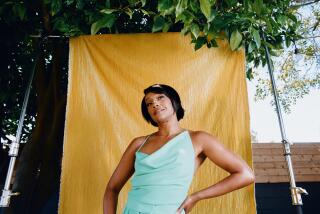Dance and Music : Taylor Troupe Powerfully Conveys 30-Year Artistry
Modern dance pursues the future so relentlessly that usually only critics and historians pause to reconsider its past.
No longer. Retrospective seasons by Bella Lewitzky, Paul Taylor and others, along with such events as the International Mark Morris Symposium in San Francisco over the weekend, are allowing everyone the benefit of cultural hindsight.
Two programs powerfully danced by the Taylor company during the weekend in Royce Hall, UCLA, surveyed 30 years of work by a choreographer at a plateau of generally acknowledged greatness. However, from the twisty body squiggles of “Junction” (the oldest work presented) to the nasty reminders of war, disease and corruption in “Company B” (the newest), Taylor’s commitment to defying expectations seemed a constant index to his artistry.
Seen Saturday, “Junction” (1961) took aristocratic cello suites by Bach and made the music fit flowing, slow-motion group movement no less comfortably than antic grab-and-melt-and-stagger solos or duets. Alex Katz’s costumes featured different colors on the front and back, so even the simplest walk-and-turn passage produced startling frissons.
Ending each program, “Company B” (1991) used Andrews Sisters recordings to evoke both the cheery media illusions and the painful personal realities of World War II America. Compared to the production by the Houston Ballet (the company that premiered the work), this edition lacked the youthful innocence that clashed so devastatingly with every hard truth Taylor conjured up on the shadow-screen backdrop.
However it would be difficult to surpass the deliberately loathsome bravura of Patrick Corbin in “Oh Johnny” or the sensitivity to loss portrayed by Constance Dinapoli and David Grenke in “Another You.” Clearly, “Company B” had more on its mind than nostalgia--but, curiously, Taylor allowed the groundbreaking “Esplanade” (1975) to degenerate into merely a “I Remember Postmodernism” love fest, replete with painted smiles.
In the performance Friday, mannerism masked the latter’s triumphant innovations: the use of Bach again for an all-American dance suite without any actual dance steps in it; the impressionistic portrait of blocked emotion midway through, resolved in the headlong athletic daring of the finale.
Taylor’s Haydn “Duet” (Saturday) found Francie Huber and Grenke skillfully exploring eloquent body-sculpture from 1964, with the choreographer’s characteristic lean-to-the-side-and-turn positioning defining an alternative standard of placement from that of classical ballet.
“Counterswarm” from 1988 (Saturday) buzzed with Ligeti string tremors and Taylored insect metaphors. Beyond a fabulously feisty solo for Denise Roberts, however, the piece appeared focused on corps spectacle. Moreover, the fussy purple and red Santo Loquasto costumes imposed an odd neo-Diaghilev glamour, as if Taylor intended something called “Spectre of the Aphid.”
Finally, “Lost Found and Lost” (Friday) dressed nearly the whole company in glittery black (with veils) and set everyone to parodying all manner of social pretense, from fashion-model poses to art dance of all kinds.
* The Taylor company performs substantially the same repertory at the Orange County Performing Arts Center on Nov. 28 and 29.
More to Read
The biggest entertainment stories
Get our big stories about Hollywood, film, television, music, arts, culture and more right in your inbox as soon as they publish.
You may occasionally receive promotional content from the Los Angeles Times.






